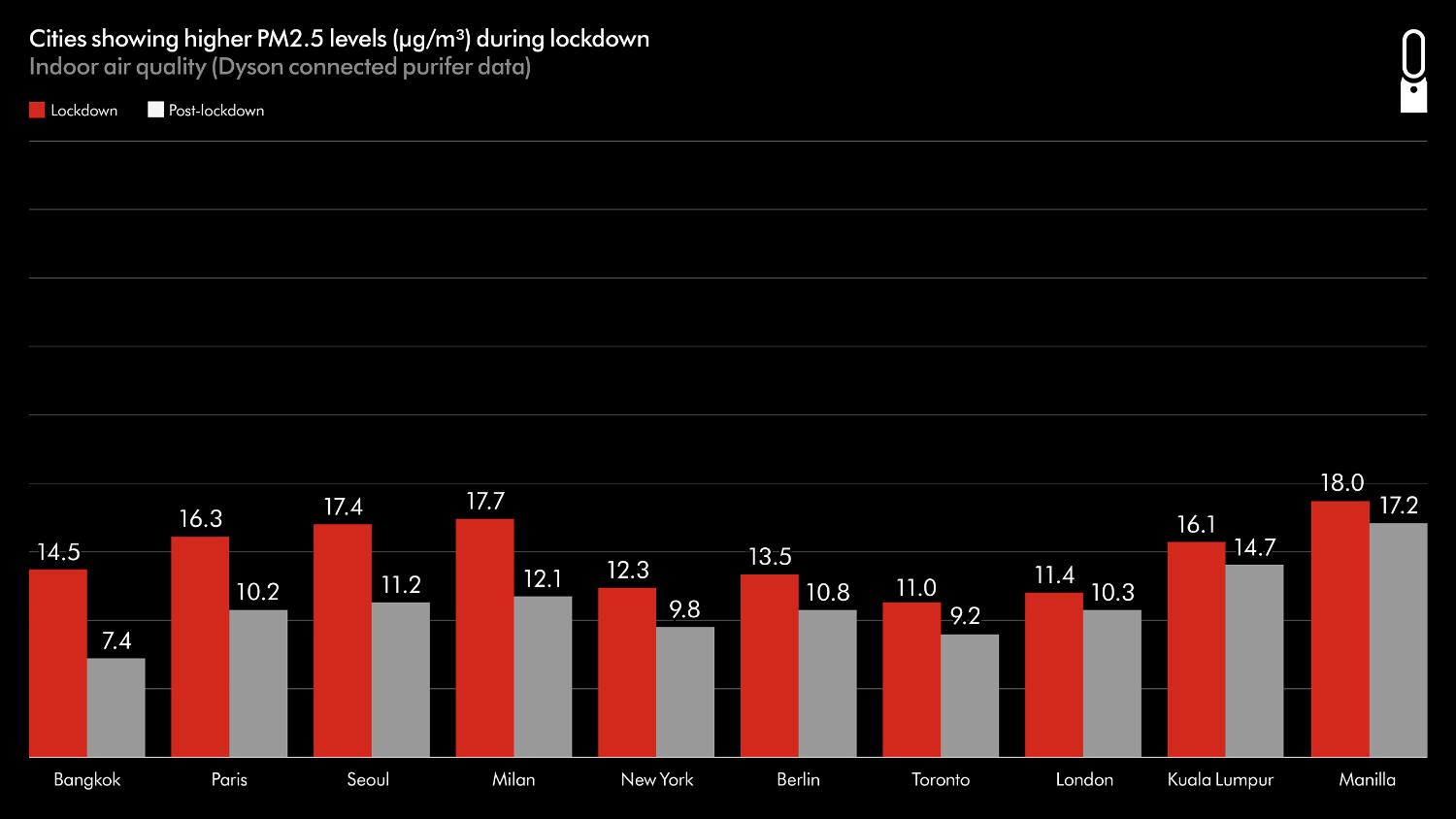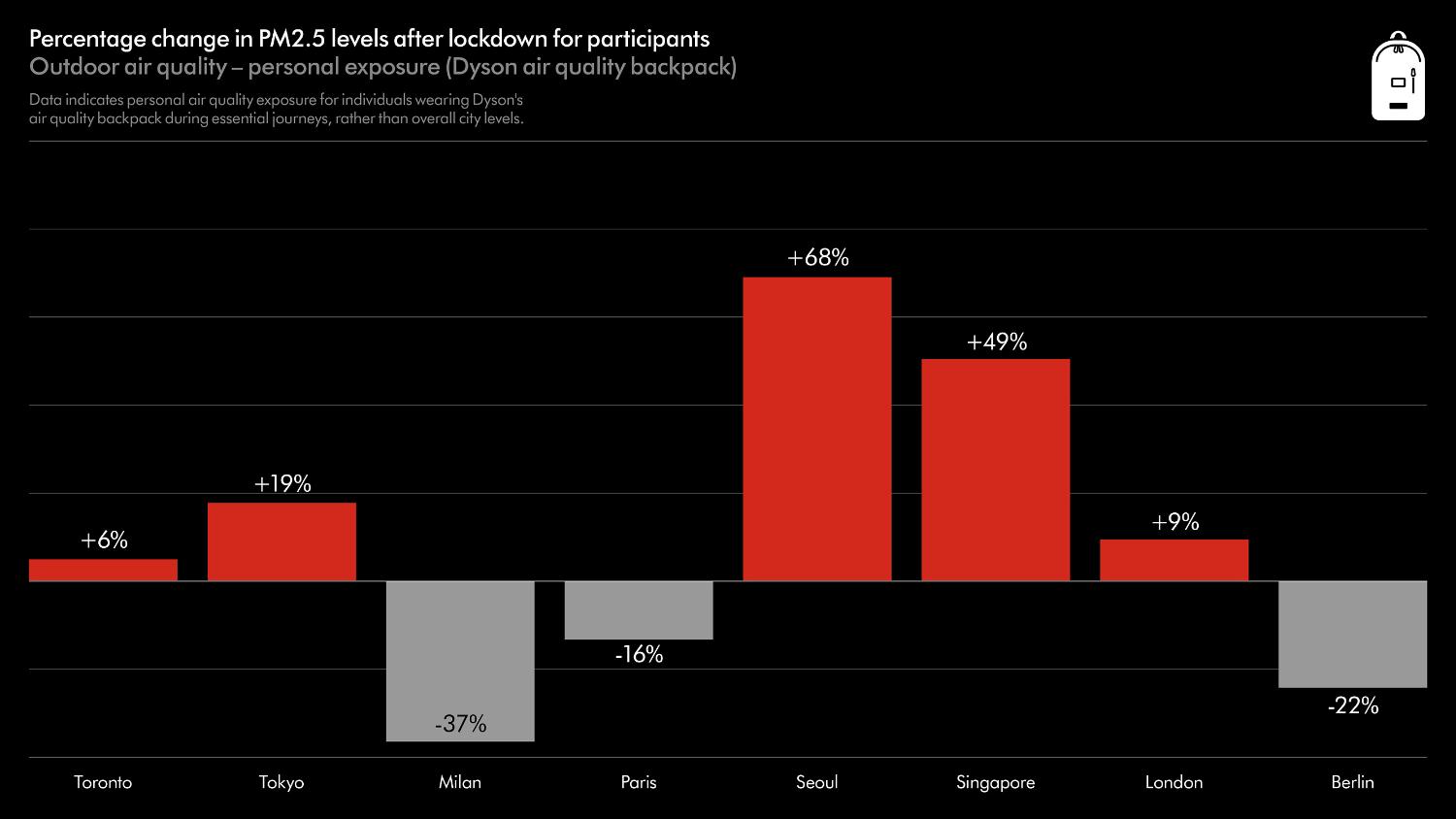-
-


Dyson urges caution over indoor air quality as purifier data indicates pollution increase during lockdown
Results from Dyson’s air quality lockdown project indicate increased PM2.5 levels indoors during lockdown and a reduction in NO2 levels outdoors.
2 December 2020
-
-
As lockdown descends on cities across the world once again, Dyson urges people to consider their indoor air pollution levels at home. Dyson purifier data collected from initial lockdowns in 14 cities globally indicated higher PM2.5 levels during lockdown compared to post-lockdown, highlighting the impact that spending more time indoors may be having on exposure to pollution.
Outdoor data collected over the same period with Dyson’s portable air quality backpack showed participants were exposed to lower NO2 levels during the lockdown period. This is likely due to the reduction of vehicles on the road during lockdown, as traffic is a common source of the pollutant.
“As people are spending more time indoors, cooking and disturbing household dust, it’s not surprising that our purifier data revealed an increase in PM2.5 pollution levels indoors. Raising awareness and educating people about air quality is such an important part of what we do at Dyson. The more information we get about it and the impact it has on people, the more we can work towards resolving some of those issues.”
Alex Knox, Vice President of Environmental Care at Dyson
-
In response to the lockdown restrictions of the COVID-19 outbreak, Dyson equipped nine individuals in eight cities around the world with its air quality backpack to understand lockdown’s impact on individual exposure to air pollution. Participants included London’s A&E and TV Doctor Alex George, Singapore Technology Journalist Bobby Tonelli, and Toronto’s Nike Master Trainer Jennifer Lau.
Re-working existing technology used in Dyson air purifiers, the air quality backpack is a portable air-sensing device. Armed with on-board sensors, a battery pack and GPS, it is able to measure air pollution data on the move[1]. Individuals wore the air quality backpack during their sanctioned essential journeys during the lockdown period between April and June, whether that be visiting the grocery store, an essential commute to work or daily exercise routes. These journeys were then revisited by participants once the cities reopened, allowing for the comparison of pollution exposure levels between the lockdown and post-lockdown period.
This outdoor data was analysed alongside outdoor air quality sensor networks, and Dyson’s vast database of anonymised indoor purifier data. Dyson engineers examined anonymous data from over 38,000 Dyson purifiers from around the world, helping to build a picture of the overall impact of lockdown on air quality both indoors and outdoors.
The Results
Dyson indoor purifier data showed higher PM2.5 levels indoors in ten of the 14 cities analyzed when compared with the post lockdown period. This may have been linked to increased human activity in the home as outdoor movement was restricted and people were asked to stay inside. Indoor sources of PM2.5 include particles released by the combustion process when cooking, wood burning stoves, carpets and the disturbance of dust while cleaning.
“I was surprised to learn of the impact of lockdown on air quality both indoors and outdoors. Although I expected outdoor pollution to increase after lockdown when cities returned to normality, I didn’t expect levels of pollution to be higher inside the home due to people spending more time indoors. I think indoor air pollution is often overlooked, and this project has really made me a lot more conscious of how my personal actions can influencer my exposure to pollution both indoors and outdoors.”
London’s participant, A&E and TV Doctor Alex George said:
-

-
Dyson’s air quality backpack results indicated an increase in NO2 exposure in the period after lockdown. One of the biggest contributors to NO2 levels in cities is traffic, highlighting the impact of increased travel as cities opened up again. Lower NO2 levels were widely reported during lockdown, with the European Space Agency’s satellite images revealing a marked change in levels globally. This reaffirms the impact that city-wide pollution changes can have on personal exposure, and why education and awareness of air pollution is so important.
-

-
Interestingly, outdoor backpack data showed a less significant PM2.5 trend between cities. This suggests that pollution levels may have been influenced by both local and wider regional pollution sources. These are often impacted by geography, climate and seasons, explaining the variation between cities. For example, the increase in PM2.5 levels recorded by the air quality backpack after lockdown in Tokyo was reflected in the data collected by the outdoor air quality sensor network. This data consistency indicates that the levels were impacted by a city-wide pollution event. Extreme examples of this include wildfires, heightened pollen activity or sandstorms. In London by contrast, the outdoor sensor network data did not reflect the PM2.5 levels recorded by the backpack data, suggesting the participant was influenced by more local pollution events, such as walking past construction or someone smoking.
“These results highlight the hyperlocal aspect of air quality both indoor and outdoor enabled by personalized exposure monitoring. Some of the sources of air pollution like traffic, construction or cooking in the home can be mitigated and are to some degree within our control to avoid, reduce or change to lower our exposure. However, some wider causes of pollution are less avoidable as they impact pollution levels on larger scale such as city scale. This removes our ability to reduce our exposure significantly as the pollution source cannot be avoided.”
Frederic Nicolas, Category Development Manager of Environmental Care at Dyson
Press contacts
-
Isabel Matthews
-







